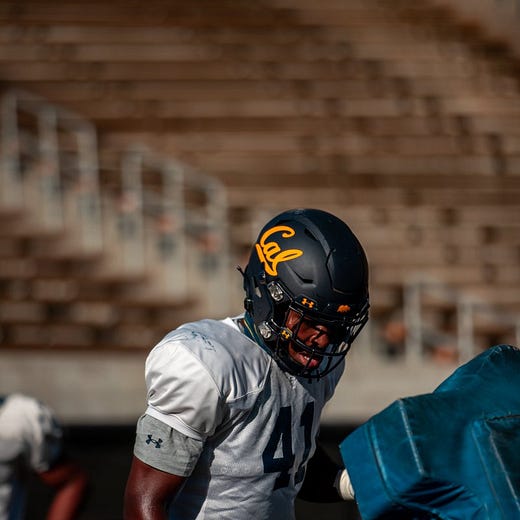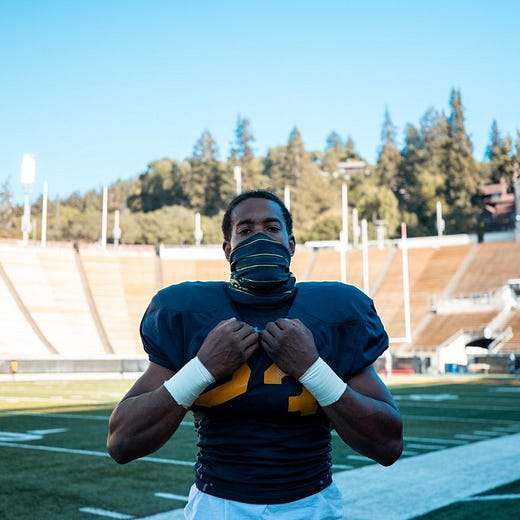Cal Football 2020 Preview: The Defense
The Bears have to replace key performers at every level of the defense, but there are enough veterans back to have confidence.
Previously in our preview series: No Frills Football ; The Offense
If you’ve been following Cal football closely over Justin Wilcox’s tenure, then most of the first half of this preview is going to be pretty boring. Wilcox defenses at Cal have consistently done certain things well, done other things less well, and put up largely similar results year in, year out, save for the randomness of turnovers. While the marginal stuff matters, in the big picture you can pretty reliably predict what a Justin Wilcox defense will look like, and this year is no different, even if there are some important changes in personnel.
What have you seen, and what will you likely continue to see? You will see a positionally sound, largely conservative defense that rarely makes mistakes, but is vulnerable to offenses that execute at a high level and can sustain drives of their own. This will likely be the case unless and until Cal recruits talent at a higher level (stay tuned!)
2019 Defense, revisited
Strengths
Preventing big plays
Probably the biggest single statistical hallmark of the Justin Wilcox defense is a near complete elimination of big plays for the opposing offense, and 2019 was no different. Cal’s pass defense was perhaps a little bit more vulnerable to smaller chunk plays, but by and large the Cal defense again kept everything in front of them and forced opposing offenses to sustain long, multi-play drives to score points.
Of course, it’s not just scheme that allowed the Bears to prevent big plays, which leads us to Cal’s other big strength . . .
Tackling
Believe it or not, but Cal’s defense allowed opposing quarterbacks to complete 64% of their passes, which was 108th in the country. And yet, despite all those completed passes, the defense was very good about preventing big plays. That tells you that the defense kept receivers from getting behind them, but also immediately tackled anybody who caught a ball underneath. Good tackling has also always been a hallmark of a Wilcox defense, and there’s no reason to expect that to change either.
Weaknesses
Stuffing run plays
Cal was bottom 10 in the country in run stuff rate, which honestly surprised me. While creating havoc on the line has been a consistent issue since, say, Cameron Jordan graduated, I still didn’t think that Cal was that unable to disrupt on the line.
Hopes that this will change likely depend on a sophomore leap from Brett Johnson, as most of the rest of the front 7 are established performers.
Turnovers forced
One year after managing 21 interceptions, the Bears returned their entire secondary and collected just 8 interceptions in 2019. If you ever wanted an illustration of why turnovers are risky, high variable events that can’t be relied upon, year to year or game to game, just compare the 2018 and 2019 Cal defense.
And honestly, subtracting 13 interceptions from the ledger explains a healthy portion of Cal’s defensive regression. That’s one more opponent possession/game with an opportunity to score that wasn’t taken away by the defense. It doesn’t completely explain Cal’s decline from allowing 1.4 points/drive in 2018 to 2.1 points/drive in 2019, but it’s a solid chunk.
Unit Summaries
Defensive line
Presumed starters:
Defensive End: senior Zeandae Johnson
Nose Guard: junior Aaron Maldonado
Defensive End: sophomore Brett Johnson
Depth: sophomore JH Tevis, true freshman Stanley McKenzie, true freshman Ricky Correia, true freshman Jaedon Roberts
While Cal suffered fewer pandemic-related departures than many teams, losing Luc Bequette off the line is probably the single most significant loss. Cal’s defensive line depth was already iffy, and losing a senior starter certainly doesn’t help. After trusted starting trio of Johnson, Johnson, and Maldonado, Cal has exactly one scholarship lineman who isn’t also a true freshman. That would be sophomore JH Tevis, who saw brief action in four games as a redshirt freshman last year.
The good news is that Cal brought in a strong class of defensive line recruits. Still, I would imagine that everybody is very much hoping that Cal’s veteran starting trio stay healthy all season so that the class of 2020 guys have a season to learn, perhaps with occasional playing time just to give the starters a quick break.
Linebackers
Presumed starters:
Outside linebacker: sophomore Braxten Croteau
Inside linebacker: sophomore Evan Tattersall
Inside linebacker: senior Kuony Deng
Outside linebacker: senior Cameron Goode
Depth: redshirt freshman Owen Patu, redshirt freshman Blake Antzoulatos
How weird is it to feel like linebacker might be the least proven position group on defense? To be fair, Deng and Goode are well known commodities, but the graduation of Evan Weaver and the opt-out decision from Tevin Paul and Ben Moos has left two spots in the lineup to be filled with relative inexperience.
Evan Tattersall and Braxten Croteau are perhaps the favorites to win the vacant starting positions, as both players saw game time last year. Croteau in particular played in every game and even picked up a start when Cal had a bunch of OLBs out injured against Ole Miss. Still, although both players saw the field they only combined for 10 total tackles. To be fair, Tattersall wasn’t going to get major snaps playing behind Weaver and Deng, and Croteau was thrust into action as a true freshman. It’s entirely possible that both are ready for a bigger role.
But redshirt freshmen Owen Patu and Blake Antzoulatos are both in competition with Croteau and Tattersall, and honestly I’d expect much more rotation than we saw in previous seasons anyway.
Secondary
Presumed starters:
Cornerback: senior Camryn Bynum
Safety: senior Elijah Hicks
Safety: junior Daniel Scott
Cornerback: sophomore Chigozie Anusiem
Nickel: senior Josh Drayden
Depth: junior Branden Smith, redshirt freshman Craig Woodson, redshirt freshman Jaylen Martin
Thanks to a savvy redshirt year from Josh Drayden, the return of Cam Bynum and unexpected playing time for Daniel Scott thanks to Ashtyn Davis’s injury-plagued 2019, the Bears are returning more experience in the secondary than expected. Hicks, Bynum and Drayden are trusted veterans, while Scott and Anusiem both got plenty of playing time last year as the first safety and cornerback off the bench, respectively.
Penn State transfer Isaiah Humphries was expected to compete for a starting spot, but he is no longer on the roster, again cutting into Cal’s potential depth.
Defining questions
Will this defense need depth, and can they build depth?
You may have noticed a theme to the unit summaries above. Generally speaking, Cal has a group of starters who are trusted veterans. But nearly every single back up is a younger, unproven player - in most cases, a redshirt or even a true freshman.
The defense lost enough critical players to graduation that depth was going to be an issue, but losing multiple players to COVID related transfers and opt-outs cuts into that depth even further.
Since Cal will only be playing 7 regular season games, maybe that lack of proven depth won’t end up mattering. Fewer games to get injured, fewer games to exhaust the starters. Maybe Cal’s younger players will be ready to step onto the field and compete right away. But don’t be surprised if at some point a freshman is thrust into a position of responsibility in a key moment of an important game.
Can the Bears rediscover their takers mojo?
Alternatively: Will the winds of random fortune blow favorably?
Over the first 6 games of the 2018 season, the Bears forced 10 turnovers, for an average of 1.7 a game. That’s just about bang on national average.
Over the last 6 games of the 2018 season, the Bears forced 16 turnovers, for an average of 2.7/game, which prorated over a full season is a rate that would lead the nation most years.
You get the point, right? The 2020 season, with 6 regular season games, will be thrilling small sample size theater. Let’s hope the fumbles bounce into the arms of Kuony Deng and the tipped passes into the waiting hands of Cam Bynum.
How obvious will Evan Weaver’s absence be?
Prior to the 2019 season, Cal fans (myself included!) overlooked the impact of losing an all-conference linebacker like Jordan Kunaszyk. I don’t think anybody will make the same mistake this year. Those 182 tackles have to go somewhere, and it’s entirely possible that Cal’s excellent ability to prevent big run plays will decline to a degree without Weaver in the middle, hoovering up every running back who makes it past a defensive lineman.
Final Outlook
Last year, Cal was supposed to have the best defense in the conference. But thanks to a variety of issues, the Bears regressed to be the 4th best defense in the Pac-12, clearly behind a trio of excellent defenses in Oregon, Washington, and Utah.
Sadly, Oregon and Washington are returning the bulk of the talent* that made their defenses so good last year, and those units will almost certainly be better than the Bears. But I think Cal is returning enough talent (and perhaps more importantly, they have good defensive coaches) that the Bears should still sport better defenses than Oregon State, Stanford, or Washington State.
In other words, I feel reasonable confident that Cal will have the 3rd best defense in the Pac-12 North, which is all that really matters this year.
If you’re the optimistic type, and you think that the Cal offense is going to take a big step forward with so much returning talent, then you would be pretty darn happy if Cal were more-or-less able to repeat the defensive performance they put on last year. There isn’t likely to be an offense on the schedule capable of shredding through a Wilcox defense the way USC and Utah did last year, and the Bears are very likely going to be the same frustrating, big-play preventing, solid tackling unit that will frustrate most offenses.
If the defense outperforms expectations, expect monster years from Kuony Deng, Brett Johnson, and Cameron Goode (THESE GUYS MUST STAY HEALTHY!), supported by a veteran secondary that gets a bit more interception luck. If the defense underperforms expectations, expect to see Cal’s depth get exploited, and watch out for more struggles shutting down running plays with a front 7 that has to break in new contributors at multiple spots.
In sum, I don’t think that Cal yet has the pure talent or the established depth to field a defense like the 2018 group that could win you a game by themselves. If you’re dreaming of Pac-12 north title contention, I think you’re better off hanging your hopes on Chase Garbers and the Cal offenses scoring much more often, supported by a defense that’s stingy and workmanlike, but not dominant. Wouldn’t it be weird, but just as nice, to watch a Justin Wilcox team that wins games 34-24 rather than 17-13?
*Sigh, I really need to get around to figuring out what other players various Pac-12 teams have lost due to COVID-related departures. Why does this year have to be so damned complicated?







Great write up as always...Gracias! Go Bears!
Another great friggin' write-up. Thanks Nick!